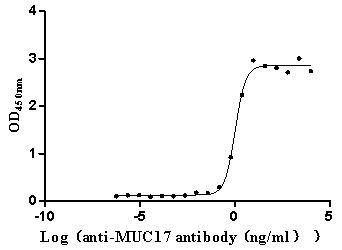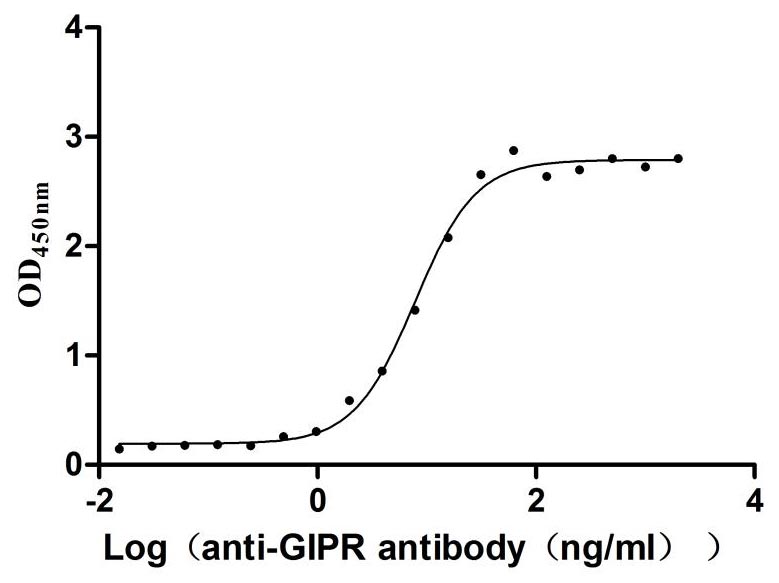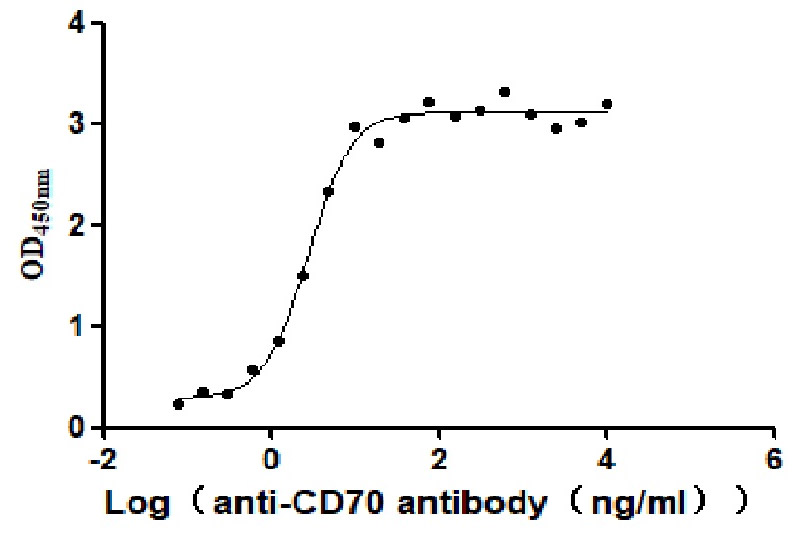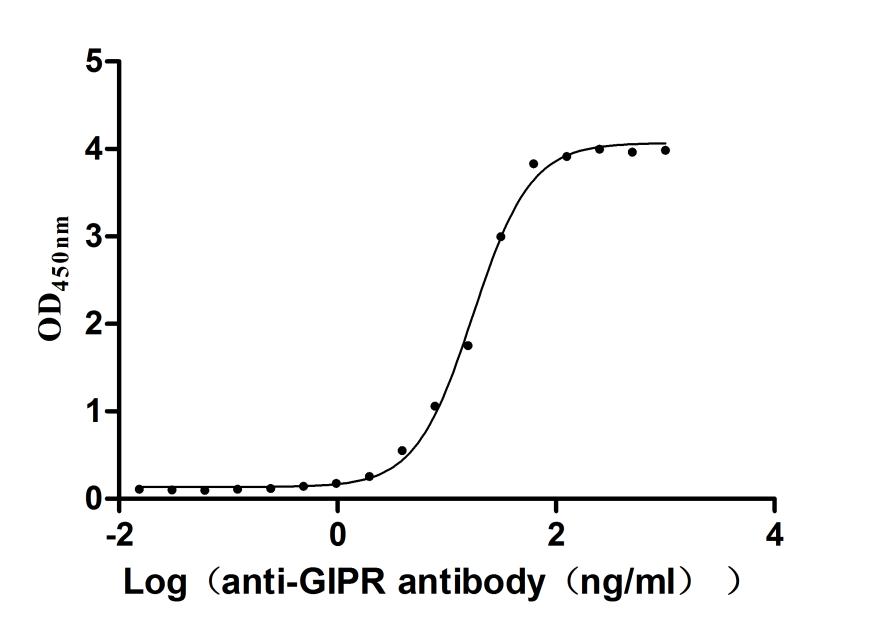Recombinant Rat Protein S100-B (S100b)
-
中文名称:大鼠S100b重组蛋白
-
货号:CSB-YP020643RA
-
规格:
-
来源:Yeast
-
其他:
-
中文名称:大鼠S100b重组蛋白
-
货号:CSB-EP020643RA
-
规格:
-
来源:E.coli
-
其他:
-
中文名称:大鼠S100b重组蛋白
-
货号:CSB-EP020643RA-B
-
规格:
-
来源:E.coli
-
共轭:Avi-tag Biotinylated
E. coli biotin ligase (BirA) is highly specific in covalently attaching biotin to the 15 amino acid AviTag peptide. This recombinant protein was biotinylated in vivo by AviTag-BirA technology, which method is BriA catalyzes amide linkage between the biotin and the specific lysine of the AviTag.
-
其他:
-
中文名称:大鼠S100b重组蛋白
-
货号:CSB-BP020643RA
-
规格:
-
来源:Baculovirus
-
其他:
-
中文名称:大鼠S100b重组蛋白
-
货号:CSB-MP020643RA
-
规格:
-
来源:Mammalian cell
-
其他:
产品详情
-
纯度:>85% (SDS-PAGE)
-
基因名:S100b
-
Uniprot No.:
-
别名:S100b; Protein S100-B; S-100 protein beta chain; S-100 protein subunit beta; S100 calcium-binding protein B
-
种属:Rattus norvegicus (Rat)
-
蛋白长度:Full Length of Mature Protein
-
表达区域:2-92
-
氨基酸序列SELEKAMVA LIDVFHQYSG REGDKHKLKK SELKELINNE LSHFLEEIKE QEVVDKVMET LDEDGDGECD FQEFMAFVSM VTTACHEFFE HE
-
蛋白标签:Tag type will be determined during the manufacturing process.
The tag type will be determined during production process. If you have specified tag type, please tell us and we will develop the specified tag preferentially. -
产品提供形式:Lyophilized powder
Note: We will preferentially ship the format that we have in stock, however, if you have any special requirement for the format, please remark your requirement when placing the order, we will prepare according to your demand. -
复溶:We recommend that this vial be briefly centrifuged prior to opening to bring the contents to the bottom. Please reconstitute protein in deionized sterile water to a concentration of 0.1-1.0 mg/mL.We recommend to add 5-50% of glycerol (final concentration) and aliquot for long-term storage at -20℃/-80℃. Our default final concentration of glycerol is 50%. Customers could use it as reference.
-
储存条件:Store at -20°C/-80°C upon receipt, aliquoting is necessary for mutiple use. Avoid repeated freeze-thaw cycles.
-
保质期:The shelf life is related to many factors, storage state, buffer ingredients, storage temperature and the stability of the protein itself.
Generally, the shelf life of liquid form is 6 months at -20°C/-80°C. The shelf life of lyophilized form is 12 months at -20°C/-80°C. -
货期:Delivery time may differ from different purchasing way or location, please kindly consult your local distributors for specific delivery time.Note: All of our proteins are default shipped with normal blue ice packs, if you request to ship with dry ice, please communicate with us in advance and extra fees will be charged.
-
注意事项:Repeated freezing and thawing is not recommended. Store working aliquots at 4°C for up to one week.
-
Datasheet :Please contact us to get it.
相关产品
靶点详情
-
功能:Weakly binds calcium but binds zinc very tightly-distinct binding sites with different affinities exist for both ions on each monomer. Physiological concentrations of potassium ion antagonize the binding of both divalent cations, especially affecting high-affinity calcium-binding sites. Binds to and initiates the activation of STK38 by releasing autoinhibitory intramolecular interactions within the kinase. Interaction with AGER after myocardial infarction may play a role in myocyte apoptosis by activating ERK1/2 and p53/TP53 signaling. Could assist ATAD3A cytoplasmic processing, preventing aggregation and favoring mitochondrial localization. May mediate calcium-dependent regulation on many physiological processes by interacting with other proteins, such as TPR-containing proteins, and modulating their activity.
-
基因功能参考文献:
- These data indicated that S100B is a novel regulator for vascular remodeling following injury and may serve as a potential biomarker for vascular damage or drug target for treating proliferative vascular diseases. PMID: 28693920
- astrocytes in the medial prefrontal cortex participate in cognitive flexibility through the astrocyte-specific Ca2+ binding protein S100beta, which improves cognitive flexibility and increases phase amplitude coupling between theta and gamma oscillations PMID: 29664924
- Study have demonstrated that S100beta-positive parenchymal stem/progenitor cell (PS)-clusters exhibit high proliferation activity and differentiate into cells positive for non-endocrine cell lineage markers in addition to endocrine cells depending on the culture conditions, whereas S100beta-negative PS-clusters show low proliferation and differentiation activity. PMID: 29684040
- The Astrocytic S100B Protein with Its Receptor RAGE Is Aberrantly Expressed in SOD1(G93A) Models, and Its Inhibition Decreases the Expression of Proinflammatory Genes PMID: 28713206
- Expression and localization of FOXJ1 in S100beta-positive multiciliated cells of the rat pituitary has been described. PMID: 27660208
- the RAGE pathway may play a possible role in malignant transformation of mesenchymal stem cells, and this process may be mediated through S100B PMID: 29050939
- These results imply that age-related AGE-albumin accumulation, S100beta, and RAGE expression are more prominent in visceral than in subcutaneous fat, suggesting that visceral fat is involved in the pathogenesis of inflammation-induced diseases in the elderly. PMID: 27301641
- S100beta-positive cells of extrapituitary origin invade the anterior lobe, undergoing proliferation and diverse transformation during pituitary organogenesis. PMID: 27695124
- Vesicle internalization likely mitigates the toxic effects of extracellular S100B and other waste products PMID: 27488079
- Maternal exposure to mercury results in increased S100B in the placenta. Zinc sulfate feeding could reduce S100B and mercury levels, thereby protecting the rats from mercury damage. S100B level may be used to measure the antagonism between zinc and mercury during pregnancy. PMID: 27928847
- Findings indicate that S100B regulates neuronal and endothelial dependent cerebral arteriolar dilation and suggest that this phenomenon is mediated through receptor for advanced glycation endproducts-associated pathways. PMID: 26773687
- Gene expression of S100B in hippocampus is slightly increased in a model of traumatic brain injury. PMID: 25898931
- These results suggest that the SOX10-S100B signaling axis critically regulates Schwann cell proliferation and myelination, and therefore is a putative therapeutic target for neuronal disorders. PMID: 25536222
- S100beta-positive cells cultured from the anterior lobe are capable of developing into hormone-producing cells. PMID: 24842050
- CXCL10 produced by a subpopulation of S100beta-positive cells probably exerts an autocrine/paracrine effect on S100beta-positive cells. PMID: 24770897
- This result suggested that S100B/RAGE interactions may be involved in the development and maintenance of depression and may play an important role in the mechanism of antidepressants' therapeutic action. PMID: 21614209
- S100beta-positive dendritic-like cells can sense an increase in extracellular protons via GPR68 and respond by the production of IL-6 in order to suppress the up-regulation of Pomc expression. PMID: 25129106
- S100beta is released by astrocytes into the extracellular compartment during the first 24 h after the spinal cord injury and represents a useful biomarker of lesion PMID: 24766228
- Cinnamon polyphenols enhanced the intracellular expression and the extracellular secretion of S100beta in rat C6 cells. PMID: 24239092
- By inhibiting S100B activation, tetrandrine prevented chronic cerebral hypoperfusion. PMID: 23561481
- Levels of serum S100B protein correlate well with amitriptyline-induced cardiovascular toxicity and can be used as a biomarker for predicting toxic cardiovascular effects of amitriptyline. PMID: 22052576
- The present study demonstrated that S100B-positive astrocytes are more prominent than GFAP-positive astrocytes in both the ventroposterior thalamus and the lateral habenula at PD 7 and the later life. PMID: 22627026
- There was an increase in S100B levels in the cerebrospinal fluid from the non-trained diabetic group (P< 0.01) and no such increase was found in the trained diabetic group. PMID: 21892662
- Data suggest that S100B secretion in brain tissue is stimulated rapidly and persistently (for at least 24 h) by ICV LPS administration. PMID: 21970823
- These findings lend support to the hypothesis that S-100 protein-positive cells are capable of differentiating into hormone-producing cells in the adult rat pituitary gland. PMID: 21830043
- Serum levels of S100B, S100A6 and S100P are associated with acute coronary syndrome, and serum levels and myocardial expression of these proteins are related to infarct size. PMID: 21663912
- Significant increases in serum S100B levels were observed in two models of depression, olfactory bulbectomy and chronic psychological stress. PMID: 20728493
- our results have shown that binding activity of p53 is associated with the regulation of S100B gene during long term potentiation PMID: 21546003
- Myoblasts downregulate S100B expression once transferred from proliferation medium to differentiation medium via a p38 MAPK-driven transcriptional mechanism. PMID: 21130124
- The major metabolites accumulating in glutaric acidemia type I activate S100B secretion in astroglial cells, indicating activation of these cells. PMID: 20437086
- S100 protein and glial fibrillary acidic protein expression increased significantly in the hippocampal astrocytes of rats with Alzheimer disease, and were inhibited by butylphthalide. PMID: 19726345
- Incubation of rat cortical slices in a medium not containing oxygen and glucose (oxygen-glucose deprivation) caused an increase in the release of S100B PMID: 19823932
- time-dependent expression of S100beta is obvious following diffuse brain injury PMID: 16524173
- The level of S100B expression increased 2-4-fold during long-term posttetanic potentiation in the hippocampus. PMID: 20027335
- Intracellular S100B might modulate myoblast differentiation by interfering with MyoD expression in an NF-kappaB-dependent manner. PMID: 20069545
- interaction of RAGE and its ligand S100B after myocardial infarction may play a role in myocyte apoptosis by activating ERK1/2 and p53 signaling. PMID: 19910580
- Brain parenchymatous pituicytes could be stained with antibodies against both GFAP and S100beta, whereas the fibrous pituicytes were only S100beta-immunoreactive. The functional significance of this cell type specificity remains to be elucidated. PMID: 19559073
- enhanced astrocytic synthesis of s-100beta in the periinfarct area precedes delayed infarct expansion. PMID: 12045670
- High glutamate decreases S100B secretion stimulated by serum deprivation in astrocytes. PMID: 12218700
- the major cytoplasmic S100B target protein in different glial cell lines in the presence of Zn(2+) and Ca(2+) is IQGAP1 PMID: 12377780
- role in synaptic and neuronal plasticity PMID: 12428274
- S100B increased in several newborn rat brain regions between second and fourth postnatal weeks. However,cerebrospinal fluid S100B decreased after the critical period for synaptogenesis. PMID: 12469878
- S100B increase is induced by hemorrhagic shock and is associated with the severity of shock. PMID: 12744484
- Addition of non-ionic detergent allowed whole capping protein to bind weakly to S100B, so the alpha-subunit C terminus can be mobilized from the surface of the capping protein molecule, by weakening the hydrophobic binding at the contact site. PMID: 14736868
- S100B increased the activity of both purified and cytoskeletal calcineurin in a Ca-dependent manner. This effect was blocked by a specific inhibitor of calcineurin activity, but not by TRTK-12 (an inhibitor of S100B binding to other protein targets). PMID: 15076760
- Reactive astrocytes may exert paracrine trophic actions through S100beta and FGF-2 in the midbrain dopamine ascending pathways after striatal 6-OHDA treatment. PMID: 15566955
- CSF S100B could be proposed as an index of efficacy of ketogenic diet for seizure disorders. PMID: 15567475
- might promote cell proliferation and interfere with NGF-induced PC12 cell differentiation by stimulating a p21WAF1/cyclin D1/cdk4/Rb/E2F pathway in an Akt-mediated manner PMID: 15572370
- Strain injury caused immediate release of S100-beta with further release by 24 and 48 hours. PMID: 15584905
- changes in the S100beta and bFGF immunoreactivities after a partial lesion of the rat midbrain ascending dopamine pathways induced by intrastriatal injection of 6-hydroxydopamine (6-OHDA). PMID: 15809219
显示更多
收起更多
-
亚细胞定位:Cytoplasm. Nucleus.
-
蛋白家族:S-100 family
-
组织特异性:Although predominant among the water-soluble brain proteins, S100 is also found in a variety of other tissues.
-
数据库链接:
Most popular with customers
-
Recombinant Human Mucin-17 (MUC17), partial (Active)
Express system: Mammalian cell
Species: Homo sapiens (Human)
-
Recombinant Rat Gastric inhibitory polypeptide receptor (Gipr), partial (Active)
Express system: Mammalian cell
Species: Rattus norvegicus (Rat)
-
Recombinant Human CD70 antigen (CD70), partial (Active)
Express system: Mammalian cell
Species: Homo sapiens (Human)
-
Recombinant Human Gastric inhibitory polypeptide receptor(GIPR),partial (Active)
Express system: Mammalian cell
Species: Homo sapiens (Human)















